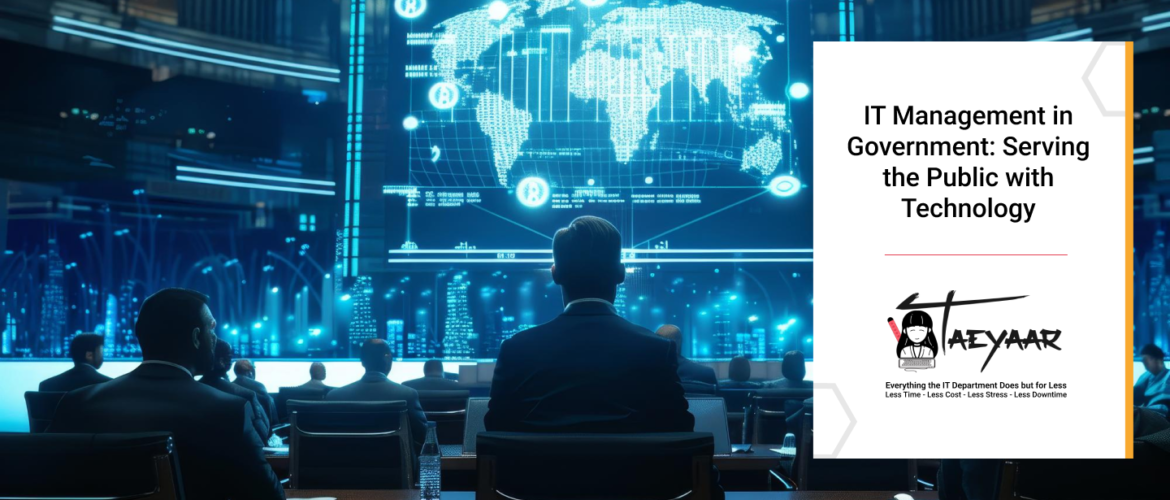Curious how governments are using technology to improve public services? That’s where IT Management in Government comes in. It’s all about using tech strategically to meet citizen needs, streamline operations, and keep things transparent. Let’s dive into the world of IT Management in Government: discovering its importance, overcoming challenges, adopting best practices, and seeing real-life examples of how it makes a difference in delivering public services.
The Crucial Role of IT Management in Government
In today’s government operations, IT Management is like the backbone, making sure technology runs smoothly to improve public services. It involves planning, setting up, and keeping an eye on all the tech stuff government offices use. From computer networks to cybersecurity, IT Management ensures that everything works well. By using cool tools like cloud computing and AI, it helps governments work faster and smarter, making services better for everyone.
IT Management also makes it easier for citizens to interact with their government. Whether it’s applying for permits online or getting info through mobile apps, technology-driven solutions make things more convenient. Plus, by investing in new tech and promoting digital skills, governments can create more jobs and opportunities for everyone. Overall, IT Management isn’t just about handling technology—it’s about making life better for citizens and building stronger communities.
One of the key objectives of IT Management is to promote transparency and accountability in government operations. By digitizing processes, automating workflows, and implementing open data initiatives, governments can increase accessibility to information, empower citizens, and build trust in public institutions. Moreover, IT Management plays a crucial role in optimizing resource allocation, reducing administrative overheads, and enhancing decision-making through data-driven insights.
Challenges Faced by IT Management in Government
While the benefits of IT Management are undeniable, governments encounter several challenges in its implementation:
1. Complex Regulatory Environment: Governments must navigate a complex regulatory landscape governing data privacy, security, and compliance. Adhering to these regulations while ensuring seamless service delivery and protecting citizen data poses significant challenges for IT Management.
2. Budget Constraints: Limited financial resources often hinder governments’ ability to invest in IT infrastructure, talent development, and innovation initiatives. Budgetary constraints may impede efforts to modernize government systems and services, limiting the adoption of new technologies.
3. Legacy IT Systems: Many governments grapple with outdated legacy IT systems that are costly to maintain, difficult to integrate, and prone to security vulnerabilities. Modernizing these systems while ensuring continuity of service presents a considerable challenge for IT Management.
4. Cybersecurity Threats: The increasing frequency and sophistication of cyberattacks pose a significant threat to government IT systems and data. Ensuring robust cybersecurity measures to protect against cyber threats while maintaining operational continuity is a constant challenge for IT Management.
Best Practices in IT Management for Government
To address these challenges and optimize the impact of IT Management, governments can adopt several best practices:
1. Develop a Comprehensive IT Strategy: Establish a clear vision and roadmap for IT initiatives aligned with government objectives and citizen needs. A comprehensive IT strategy serves as a guiding framework for IT Management efforts across government agencies.
2. Embrace Digital Transformation: Emphasize digital transformation initiatives to modernize government services and improve accessibility. Leverage emerging technologies such as cloud computing, mobile applications, and artificial intelligence to enhance service delivery and responsiveness.
3. Prioritize Cybersecurity Measures: Invest in robust cybersecurity measures to protect government systems, networks, and data from cyber threats. Implement encryption, access controls, and security protocols to mitigate risks and ensure compliance with regulatory requirements.
4. Invest in Talent Development: Build a skilled IT workforce capable of driving innovation and managing complex IT projects. Provide training, mentorship, and career development opportunities to cultivate a culture of continuous learning and professional growth within government agencies.
5. Foster Collaboration and Partnerships: Collaborate with industry stakeholders, academia, and the private sector to leverage expertise, resources, and best practices in IT Management. Engage in joint initiatives and public-private partnerships to address common challenges and drive innovation in government IT.
Real-World Examples of IT Management in Government
Several countries have successfully implemented IT Management initiatives to improve public services:
1. Estonia: Estonia’s e-government initiatives, such as e-Residency and online voting, have transformed public service delivery, making government services more accessible and transparent to citizens.
2. Singapore: Singapore’s Smart Nation vision leverages technology to enhance urban living and citizen engagement. Initiatives such as the National Digital Identity system and Smart Nation Sensor Platform pave the way for a more connected, efficient, and sustainable urban environment.
3. United States: Agencies like the U.S. Digital Service are spearheading digital innovation efforts across federal agencies, improving service delivery and cybersecurity. Initiatives such as cloud migration and agile development are modernizing government services and enhancing transparency and accountability.
Conclusion
In conclusion, IT Management in Government plays a pivotal role in driving digital transformation and enhancing public services. By addressing challenges and adopting best practices, governments can leverage technology to meet citizen needs more effectively and build trust in public institutions. As governments continue to embrace digital innovation, investing in IT Management will be essential for building resilient and future-ready societies.



